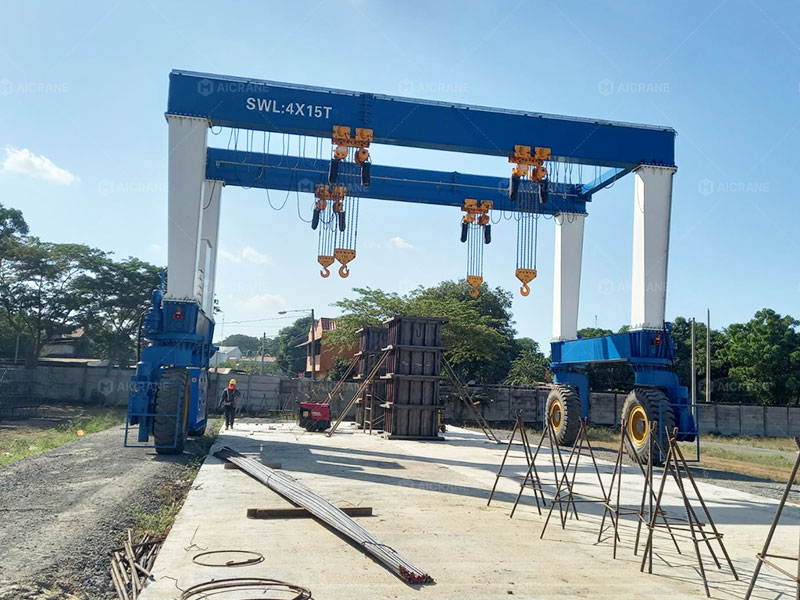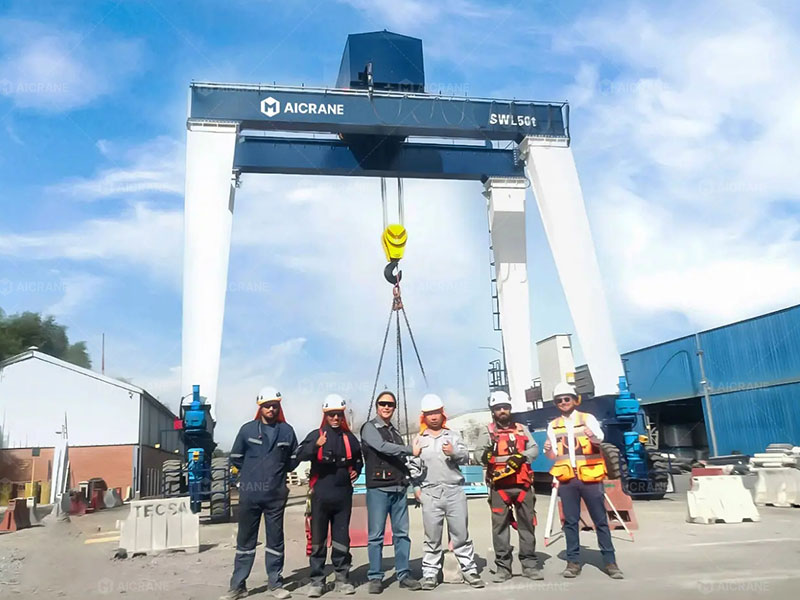Rubber Tyred Gantry (RTG) cranes are essential pieces of equipment in container terminals, logistics centers, steel yards, and precast concrete plants. They offer flexible movement, high lifting efficiency, and easy maneuverability, making them ideal for modern material handling operations. However, the price of a rubber tyred gantry crane can vary widely depending on its technical specifications, design complexity, and manufacturer.
This article explores the key factors that determine the cost of a rubber tyred gantry crane, helping businesses understand where their investment goes and how to make cost-effective purchasing decisions.

1. Lifting Capacity and Structural Design
The lifting capacity is one of the most critical elements influencing RTG gantry crane cost. It determines the size and strength of the entire structure, including the girders, legs, and trolley system.
-
Light-duty RTG cranes (10–30 tons) are generally used for small logistics yards or light material handling. They require less steel and smaller hoisting mechanisms, resulting in a lower cost.
-
Medium to heavy-duty RTG cranes (40–100+ tons) require reinforced steel structures, stronger motors, and high-performance hoisting systems. These cranes are significantly more expensive due to increased material use and engineering precision.
The crane configuration also plays a role in pricing:
-
Single girder RTG cranes are simpler, lighter, and more affordable.
-
Double girder RTG cranes offer higher lifting capacities, longer spans, and better stability, but they cost more because of their complex design and added components.
Additionally, span length (the distance between the legs) and lifting height (the maximum height the hook can reach) both influence cost. A longer span requires a stronger frame, while greater lifting heights demand longer wire ropes and larger hoisting drums, all adding to manufacturing and installation expenses.
2. Power Source and Drive System
The type of power system chosen for an RTG crane has a direct impact on both its upfront and operating costs.
-
Diesel-powered RTG cranes are still widely used due to their mobility and independence from external power sources. They have a lower purchase price but higher long-term operating costs because of fuel consumption and maintenance.
-
Electric rubber tyred gantry cranes (E-RTG), which draw power from a cable reel system or busbar, are becoming more popular. They are more expensive initially but much more energy-efficient and environmentally friendly. Over time, their reduced fuel and maintenance expenses can offset the higher initial investment.
-
Hybrid RTG cranes combine diesel generators with energy storage systems, such as batteries or supercapacitors. These advanced designs have the highest upfront cost but offer significant fuel savings and emission reductions.
The drive system – which controls the gantry’s movement and steering – also affects pricing. Multi-directional or 90-degree steering systems enhance flexibility but require sophisticated hydraulic or electric mechanisms, increasing costs.
3. Electrical and Control Systems
Modern RTG cranes are equipped with advanced control systems to improve safety, efficiency, and precision. The more automation and technology involved, the higher the cost.
-
Basic control systems with manual or semi-automatic operation are more economical.
-
Fully automated or intelligent systems, featuring anti-sway technology, load monitoring sensors, and remote operation, significantly raise the price due to advanced electronics and software integration.
Optional smart features, such as PLC (Programmable Logic Controller) systems, GPS-based positioning, and collision prevention sensors, enhance operational efficiency but also add to the total cost.
Moreover, the quality of electrical components – including inverters, cables, and contactors – affects both performance and cost. Choosing reliable components from top international brands ensures better durability and reduced downtime, which is a worthwhile long-term investment even if it raises the initial purchase price.

4. Material Quality and Manufacturing Standards
The quality of steel and materials used in crane construction plays a significant role in determining the rubber tyred gantry crane price. High-strength, corrosion-resistant steel costs more but provides longer service life, reduced maintenance, and better performance under heavy loads or harsh environments.
Manufacturing standards also influence cost. Cranes built according to European standards (FEM/DIN) or ISO/CE certifications typically involve more rigorous design, testing, and quality control processes, leading to a higher price tag. However, these cranes often deliver superior safety and reliability, making them a better long-term investment.
Buyers should also consider the surface treatment and paint system, especially for cranes operating in coastal or humid environments. Anti-corrosion coatings, galvanization, or special marine-grade paint systems increase cost but extend the crane’s lifespan.
5. Customization and Optional Features
Every operation has unique requirements, and customization can greatly influence the total cost of an RTG crane. Some common custom options include:
-
Different span lengths or wheelbases to fit existing yard layouts.
-
Variable speed drives for more precise control.
-
Cabin type and configuration, such as elevated cabins or air-conditioned enclosed operator cabins.
-
Advanced safety features, including overload protection, emergency stop systems, and video monitoring.
While these options add to the upfront price, they often improve operational efficiency and safety, providing long-term returns through reduced downtime and accidents.
6. Manufacturer and Brand Reputation
The manufacturer’s expertise and brand reputation significantly affect pricing. Established gantry crane manufacturers with proven track records generally charge more because their cranes come with better design reliability, longer warranties, and stronger after-sales support.
Lower-cost options from lesser-known brands may appear attractive, but they sometimes compromise on materials, quality control, or technical documentation. This can result in higher maintenance costs and shorter lifespan, offsetting any initial savings.
It’s also worth noting that manufacturers with integrated production and testing facilities can offer more competitive pricing compared to resellers or trading companies, who add margin to the equipment cost.
7. Transportation, Installation, and After-Sales Service
The total cost of an RTG crane extends beyond the equipment itself. Buyers must also consider shipping, insurance, installation, commissioning, and maintenance.
-
Transportation costs depend on crane size, port location, and shipping method. Large gantry cranes often need to be shipped in parts and assembled on-site, which increases logistics costs.
-
Installation and commissioning expenses vary depending on the complexity of the crane and the availability of local technical teams. Some suppliers offer on-site or online installation guidance to reduce costs.
-
After-sales service—including spare parts availability, maintenance support, and warranty coverage – also contributes to the long-term cost of ownership.
A supplier offering comprehensive after-sales support may charge more initially but saves customers money over the crane’s service life through reliable performance and minimized downtime.
8. Market Conditions and Raw Material Prices
Lastly, external factors such as global steel prices, exchange rates, and shipping costs can cause fluctuations in RTG crane pricing. When steel prices rise or logistics costs increase, manufacturers often adjust their quotations accordingly.
Similarly, currency exchange fluctuations can impact international buyers, especially those purchasing cranes from overseas suppliers. Monitoring market conditions and planning purchases strategically can help reduce total investment costs.
Conclusion: Balancing Cost and Value
The cost of a rubber tyred gantry crane is the result of multiple intertwined factors – technical specifications, materials, control systems, power configurations, and service quality. While it’s tempting to focus solely on the initial price, the total cost of ownership (TCO) provides a more accurate picture of long-term value.
A high-quality, energy-efficient RTG crane with reliable after-sales service may require a higher upfront investment, but it delivers better performance, lower operating costs, and longer service life. For businesses aiming for sustainable and efficient operations, understanding these cost determinants is the key to making a smart and strategic investment.